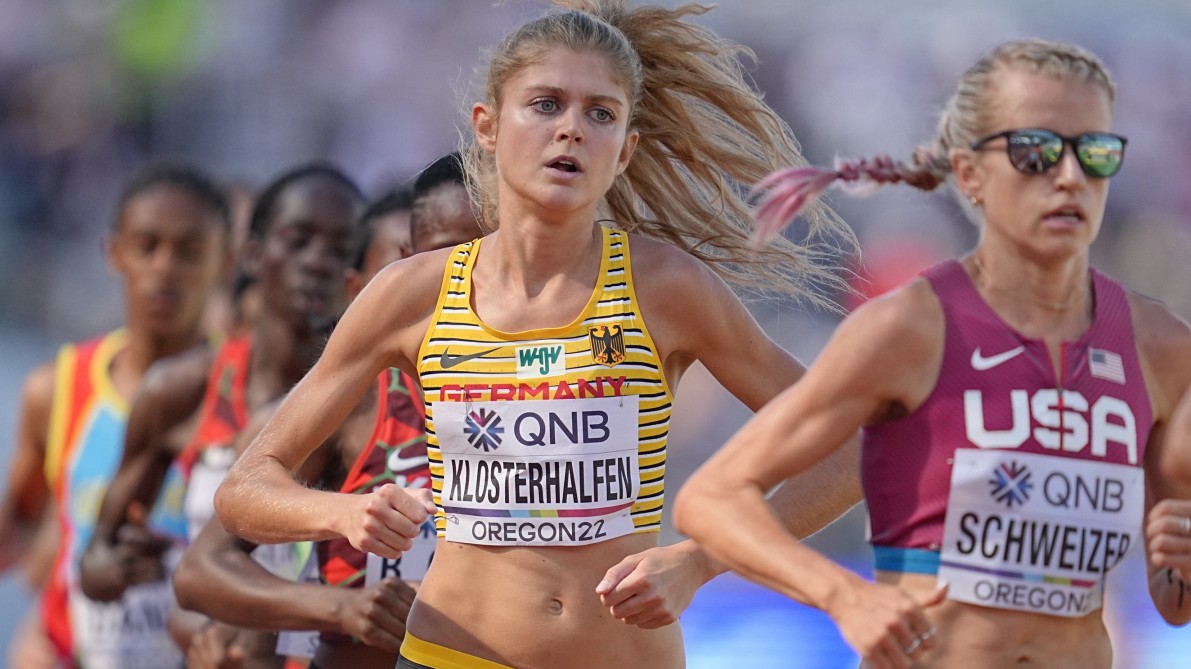With three laps to go, Konstanze Klosterhalfen knew something was wrong. She had felt good before this lead over 5000 meters, many of her competitors already had the 10,000 meters in their legs, which Klosterhalfen had left out after a Covid infection a few weeks ago. Even the heat on Wednesday afternoon in Eugene – even as a walker you felt like you were in an oven – “doesn’t bother me that much,” she said later. She quickly cleared a good position to later, in the sprint, get one of the places that entitle her to take part in the final. No problem for Klosterhalfen, in normal form.
And then, “from now on,” when the others increased the tempo and Klosterhalfen thought that things were moving forward: “It just wasn’t possible anymore.”
For Konstanze Klosterhalfen, these World Championships should also be a home game. She has been living and training in Portland, two hours north of Eugene, at the headquarters of her outfitter Nike for around three years. It should also be a kind of comeback: After two years enriched by injuries, “I would have liked to show that I’m back,” she said. That failed miserably with her time of 15:17.78, 17 seconds slower than the last runner who advanced to the final.
Klosterhalfen had won bronze at the World Cup three years ago
Not much has been seen or heard from her since the World Championships in Doha three years ago, where Klosterhalfen won bronze in the 5,000 meters. When the summer games in Tokyo started a year late, she had suffered from an overuse reaction in her hip. After eighth place over 10,000 meters, she sat in the catacombs, freezing and crying. Last winter, she was warming up in a parking garage before an indoor competition and fell.
At the Diamond League at the end of May, she broke Paula Radcliffe’s European record for the (rarely run) two miles in 9:16.73 minutes, the next record on her bulging letterhead. Then, in the altitude training camp in Switzerland: Corona positive. “Maybe,” she said in Eugene, “at the end of the day, it’s those two weeks off from training that were missing.” But she doesn’t know that for sure. You have to analyze that first.
The other is her environment, from which not much has been revealed to the outside for years. When she joined the Nike Oregon Project (NOP) in 2018, head coach Alberto Salazar and his intimate Pete Julien, her supervisors also dropped her in a group that – ex-athletes and coaches had long since revealed – at least in the gray area for years was operated. Oliver Mintzlaff, managing director of RB Leipzig and Klosterhalfen’s mentor on the side, dismissed this as “any guesswork”; he alone saw an environment that would unleash his athlete’s talent. Just before Doha, Salazar – and Mintzlaff – got it in black and white that the coach had broken anti-doping protocol by trying testosterone ointments and IVs on staff and sons.
The incidents happened years before Klosterhalfen moved to the United States. But anyone who is active in an industry that squeezes performance out of athletes at any price also moves into a very long shadow. Travis Tygart, the head of the American anti-doping agency, only said again in Eugene when he was asked about the former NOP members: “Every athlete is presumed innocent as long as he has not been convicted in court. But I fool it already told my child: You will also be judged by the environment you surround yourself with.”
When the NOP was wound down to Doha, Klosterhalfen (and Mintzlaff) opted to remain loyal to the environment that Pete Julien continued under the new flag. Since then, inquiries from many German media, especially those who reported critically about Klosterhalfen, have remained unanswered. In her few interviews, she usually does the same thing: the trainers in Oregon are great, she competes with the best athletes in the world every day, and she strictly rejects illegal methods.
That Mary Cain and other ex-NOP runners reported that Salazar had made derogatory comments about them – terrible, but only positive things had happened to her in the NOP environment. The Center for Safe Sports, an independent US body that investigates abuse, has banned Salazar from coaching for life for “sexual misconduct.” When a reporter asked Klosterhalfen in Eugene about the turbulence surrounding the NOP, she blocked it: It was a thing from the past.
And the German Athletics Association, supported by Nike for years? One does not necessarily have the feeling that those responsible there have any real influence on Klosterhalfen’s environment – even if they contradict it. The DLV always assures that Klosterhalfen is advised closely, even in the case of their weight, which at 48 kilograms and 1.74 meters in height often caused debates and long-distance diagnoses. The “substantive responsibility” for Klosterhalfen training in Portland was shouldered by the athlete and management. When the DLV last announced that it was still uncertain whether Klosterhalfen in Eugene would also compete in the 10,000 meters, their training group had long announced on social media: Klosterhalfen started over 5,000 meters, done.
And now? The first question is whether the 25-year-old will get going for the European Championships in about three weeks. Klosterhalfen in Eugene said she had trained at altitude for a very long time this year, and she also experienced the three weeks before the World Cup, after her Covid break, “very intensively” again. She actually thought, she said a little helplessly, that the worse races were finally behind her.
